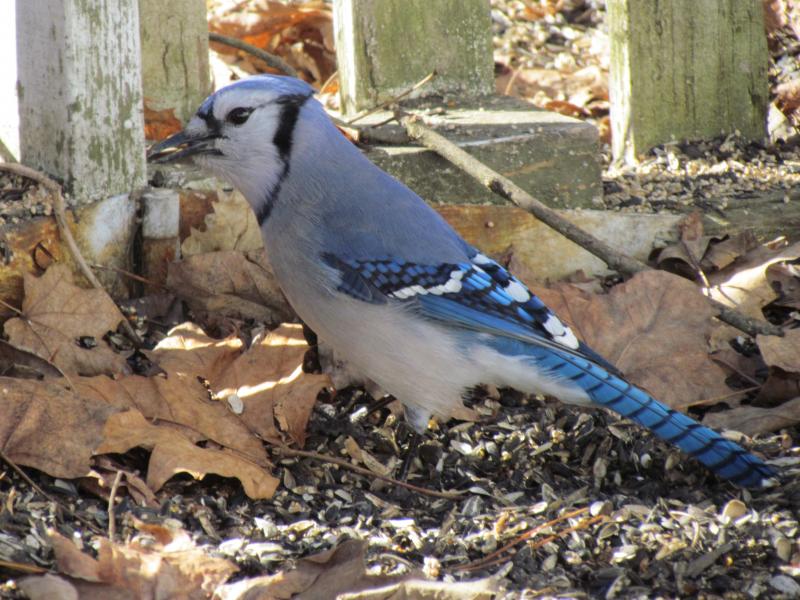This morning we heard the calls of a loon reverberating around the neighborhood. We normally don’t hear loons in our area (we are miles from a true lake) so it was a surprise. Loons occasionally call in migration; perhaps this was one calling as it migrated or just flew from one lake to another, passing over us as it went.
Hearing those loon calls made us think about how, as we slide gently from summer to fall, the natural soundscape around us changes, too. The chorus of crickets is one noticeable element of the sounds of late summer and early fall. But did you know that there are actually many kinds of insects that make those sounds we characterize as “crickets?” They include the familiar black field crickets but also ground crickets, tree crickets, meadow katydids, conehead katydids, bush katydids, and grasshoppers. We are always surprised to find, when we can concentrate enough, that what sometimes sounds like an overwhelming wall of cricket noise actually usually contains identifiable sounds of a number of different species (even though we may not always know what species they are!).
A few birds sometimes carry over their songs into late summer and fall. Red-eyed vireos will continue their sweet, robin-like phrases of “see me, here I am, look at me” into the waning days of late summer, although we haven’t heard one for about a week. Northern cardinals will keep on singing quite strongly into the fall. Mourning doves, too, and the occasional tufted titmouse will do the same. Male American goldfinches may actually be singing more at this time of year as they sometimes breed late in the season, their nesting timed with the abundant fall seeds that goldfinches feed their young.
Young birds often will begin experimenting with singing in the fall, giving jumbled songs that sound only vaguely like the polished songs of spring. We have been hearing some of these in our yard of late, some of which seem to be coming from juvenile house finches and some from young song sparrows.
Just in the last week, we have noticed the lack of some of the familiar bird sounds of summer. The high, chittering notes of chimney swifts disappeared from our skies; the last ones we heard were perhaps three or four days ago. About 10 days ago we had noticed that the chimney swifts were forming into larger flocks of 20 to 30 birds instead of the smaller groups of 2 to 5 that we had seen all summer. Presumably they are now well on their way to South America for the winter.
For us, one of the most iconic bird sounds of autumn has always been the call of the blue jay. Maybe it’s because it is more striking to hear it when there’s not a chorus of singing birds like we have in the spring and summer. Or maybe blue jays are more vocal in the fall. But whatever the reason, the ringing call of the blue jay always makes us think of cool, autumn days and forests changing from green to orange and yellow.
Some of the sounds of fall that we most enjoy can mostly only be heard at night. And no, we’re not talking about owls, although owls do sometimes call in the fall. We’re referring to the flight calls of nocturnally migrating birds. As we have written here before, most birds do most of their migrating at night, and Maine is in the path of the billions of birds that fly south each fall from their Canadian Boreal Forest nesting grounds. Sitting out at night here in Maine in the fall, it’s possible for a person to hear the short, high calls of hundreds of birds flying over in the dark. The last week we have been doing some early evening listening and hearing a moderate number of calls—ranging from two to three calls a minute. Simple math would tell you that this means that in an hour or so, one might hear more than a hundred calls of these night-migrating birds on their incredible journey south.
We hope you can all tune into some of these wonderful elements of Maine’s autumn natural soundscape!
Jeffrey V. Wells, Ph.D., is a Fellow of the Cornell Lab of Ornithology. Dr. Wells is one of the nation's leading bird experts and conservation biologists and author of “Birder’s Conservation Handbook”. His grandfather, the late John Chase, was a columnist for the Boothbay Register for many years. Allison Childs Wells, formerly of the Cornell Lab of Ornithology, is a senior director at the Natural Resources Council of Maine, a nonprofit membership organization working statewide to protect the nature of Maine. Both are widely published natural history writers and are the authors of the book, “Maine’s Favorite Birds” and the newly published “Birds of Aruba, Bonaire, and Curaçao” from Cornell Press.





























